Menu
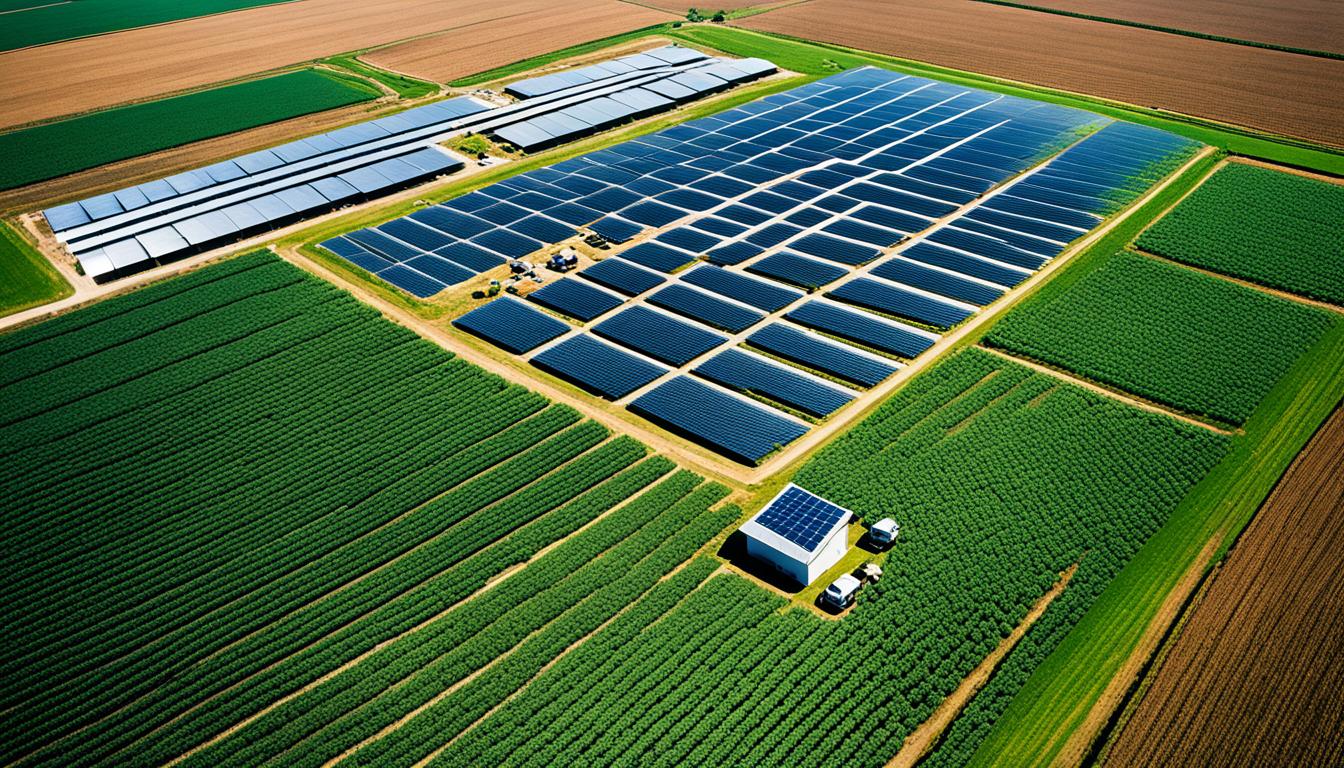
Did you know agriculture causes 26% of the world’s greenhouse gases? This shows a big need for ways to cut these emissions by farming sustainably. Sustainable farming includes methods that care for the earth. These methods help reduce the carbon footprint of producing food. This makes our environment more able to handle changes in climate.
The phrase ‘carbon footprint’ means the amount of greenhouse gases something makes. Sustainable farming tries to lower this. It does this by using resources well, keeping soil healthy, and using renewable energy. For example, planting cover crops reduces the gases the soil releases. Also, changing how we use nitrogen fertilisers can cut a harmful gas called nitrous oxide. And, using drones to put fertilisers only where they’re needed shows how advanced sustainable farming is.
Sustainable farming is key in the fight against climate change. It revolves around using methods that protect our environment. Practices like crop rotation and organic fertilisation help cut down on harmful gas emissions.
Many studies show how important sustainable farming is. For example, work by Prasad and others in 2017 proves that eco-friendly methods reduce agriculture’s gas output. This means our farming is not as hard on the environment.
In Australia, Sejian and his team noticed a drop in carbon footprint in dairy farms that went green. They used sustainable methods. A study in Europe supported this, showing that going green benefits nature everywhere.
I believe that switching to sustainable farming is crucial. It can make our food system kinder to the planet. By using green methods, we can lower the food sector’s share of harmful gas emissions to protect our world.
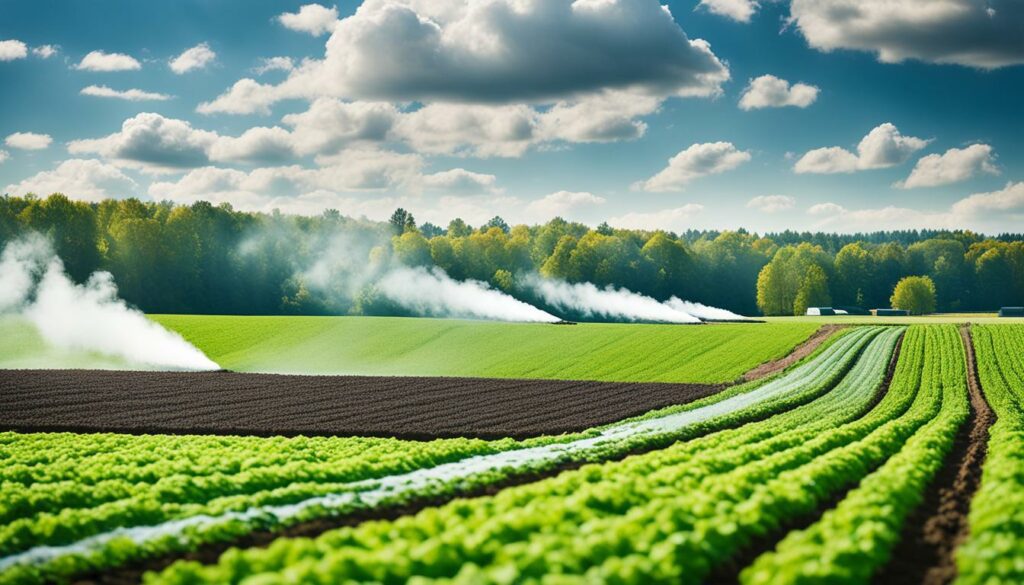
The farming sector is a major source of greenhouse gases (GHG). Yet, it can cut these emissions with smart steps. We’ll look at some ways to lower GHG emissions. We’ll see why eco-friendly methods beat the older ways.
Farmers have many choices to lower their greenhouse gas load. One smart move is to mix crops and animals together. This helps recycle nutrients and brings down emissions. By changing what they feed animals, and using special containers, farmers can cut how much methane their animals produce. They can also use more natural fertilisers. This, with smart testing of plants and soil, makes sure the land uses these nutrients well. That cuts down on bad emissions.
New ways of farming can also help. Farming without turning the land (no-till) means less need for big machines. This cuts down on fuel use and pollution. Changing over to energy sources like plants that make biofuels, windmills, and solar panels also helps cut the carbon we put out. And then, there’s the soil itself. By planting cover crops and farming in ways that don’t disturb the soil much (ground conservation), farmers trap more carbon. This is a really big deal in fighting climate change.
Older-style farming often means heavy use of chemicals and focus on just one crop. This leads to big emissions of carbon dioxide and other harmful gases. But there’s a better way. Using sustainable practices looks at the whole farm. It aims to cut pollution and keep the land healthy for the long run. This helps not just with emissions, but also with keeping the environment and farm economy strong.
When farms are tilled a lot, it can harm the soil, letting carbon escape. But using fewer tillage methods helps the soil keep this carbon. This is very good for the climate. Also, instead of chemicals, the use of natural fertilisers in the right ways keeps nitrous oxide gases low. Plus, it helps the farm to be healthier over time.
| Aspect | Traditional Methods | Sustainable Methods |
|---|---|---|
| Soil Management | Extensive tillage | No-till farming, conservation tillage |
| Crops | Monoculture | Cover crops, crop rotation |
| Fertilisers | Chemical fertilisers | Organic fertilisers, slow-release |
| Emissions | High GHG emissions | Reduced GHG emissions |
| Energy Source | Conventional fossil fuels | Renewable energy: biofuel, wind, solar |
Moving to green, smart farming does a lot of good. It doesn’t just lower GHG emissions. It helps our planet and our finances too. Strategies like using the land to trap carbon and farming in ways that protect the soil can keep us going strong for the future.
It’s key to know how soil helps in capturing carbon for better farming. Soil holds more carbon than both the air and plants. This makes soil very important in the fight against climate change.
Soil’s ability to take in carbon relies a lot on how we farm. Cover cropping and no-till farming are great examples. They help soil stay rich, stop it from washing away, and let water sink in. All this helps to lock more carbon in the ground.
Regenerative farming is about using different eco-friendly ways to farm. It makes the soil healthier while storing carbon. Bringing trees into farms through agroforestry is one way. It boosts carbon storage and makes soil better. Alley cropping and silvopasture use space smarter, helping more carbon stay locked away.
| Technique | Benefits |
|---|---|
| Cover Cropping | Enhances soil fertility and stores carbon |
| No-Till Farming | Reduces erosion and increases water infiltration |
| Agroforestry | Sequesters carbon and improves soil health |
| Alley Cropping | Maximises land use efficiency |
| Silvopasture | Boosts biodiversity and sequesters carbon |
| Perennial Crops | Deep roots store carbon and enhance soil health |
Adding compost and biochar to soil is crucial. They turn trash into things that make soil better and hold more carbon. These ways of farming lower CO2 in the air while making soil and farms healthier.
Regenerative farming is about more than just growing food. It’s a way of farming that helps the environment too. It focuses on making the soil healthy again, boosting plants and animals, and improving the water cycle. These methods are very different from the usual ways of farming. They aim to not just keep things as they are but make them better. This is a big step in fighting against climate change.
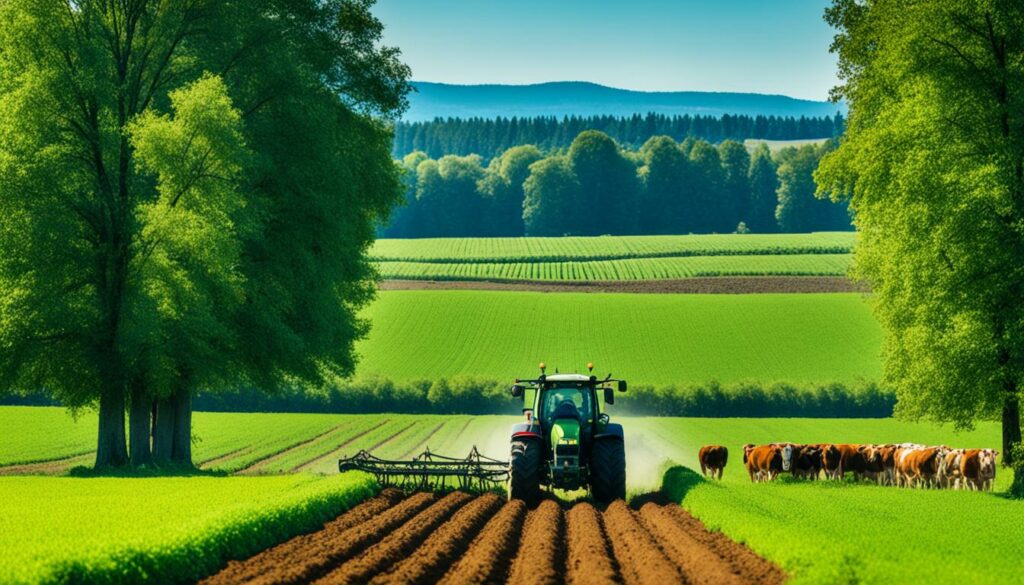
Since people started farming, we’ve lost a lot of carbon from the soil. In fact, about 133 gigatonnes of carbon have disappeared. This loss is like adding 480 gigatonnes of carbon dioxide into the air. But, regenerative farming can help turn this around. By using these methods, our soil can start grabbing carbon back. This is a key way to slow down climate change.
Regenerative farming can actually trap about 1.5 gigatonnes of carbon dioxide every year. It’s happening on over 600 million hectares of land worldwide. And, more and more land is being used this way each year. These methods make farming areas stronger. At the same time, they help fight climate change hard.
There are many places where regenerative farming is working well. Take the story of maize and mucuna in Central America. This crop rotation method is helping 25,000 farmers in three countries. In Africa, letting trees grow back naturally is turning 24 million hectares of land green again. These stories show how powerful regenerative farming can be. It makes the land better and helps it stand up to bad weather.
The way we usually farm can harm the soil a lot. Regenerative farming, however, keeps the soil healthy. It avoids using machines that can damage the land. These methods slow down how quickly the soil gets washed away. And, they help farmers deal with floods and droughts better.
Regenerative agriculture aims to draw down carbon, reduce synthetic inputs, conserve water, replenish waterways, and grow healthier foods while employing people within their communities.
Having animals on a farm can make regenerative methods even stronger. Animals can help in many ways. They make the earth richer by bringing nutrients back. They also help save water and stop bugs and weeds, all without using harmful chemicals. This way of farming is all about working with nature, not against it. It’s about keeping the soil and nutrients moving in a healthy way.
Regenerative farming can also save farmers a lot of money. They don’t need to buy as many medicines or chemicals. Instead, they use plants like buckwheat and vetch to keep the soil healthy. These plants also make money for the farmers. So, regenerative farming is good for the Earth and for business too.
Regenerative farming is more than just a trend. It has the power to change how we think about farming and the environment. By taking good care of the soil and living things, it offers hope in the fight against climate change. These methods point towards a future where farming helps, not hurts, our planet.
The difference between sustainable and conventional farming is clear when we look at their environmental impact. Sustainable farming works with nature, not against it. It uses methods that fit well with natural processes. This helps keep a good balance. On the other hand, conventional farming depends a lot on chemicals and machines. This approach harms the environment more.
When we talk about the carbon footprint, it’s a key point. Food from urban agriculture releases 0.42 kgCO2e per serving. This is six times more than food from conventional methods. A specific type, called collective gardens, has the highest carbon amount. It’s at 0.81 kgCO2e per serving. But, individual gardens and urban farms aren’t far behind, with 0.34 kgCO2e each.
Surprisingly, urban farms can have a carbon footprint as low as conventional ones. Many urban farms put out only 0.08 kgCO2e per serving. But, the efficiency of urban farms changes from place to place. For example, Poland has lower impacts than the UK.
Looking at tomatoes, those grown in urban areas do better than regular ones. Urban tomatoes release 0.17 kgCO2e each. This is lower than the 0.27 kgCO2e from conventional ones. This shows that certain crops, when grown in cities, can be kinder to the planet. It depends on how they are grown and shipped.
The following table summarises the carbon footprints observed in various agricultural setups:
| Type | Carbon Footprint (kgCO2e/serving) |
|---|---|
| Urban Agriculture | 0.42 |
| Conventional Agriculture | 0.07 |
| Collective Gardens | 0.81 |
| Individual Gardens and Urban Farms | 0.34 |
| Urban Tomatoes | 0.17 |
| Conventional Tomatoes | 0.27 |
The main reason for the difference in emissions is how urban farming is set up. Things like raised beds, walkways, and certain farming tools add to its carbon footprint. Conventional farming is more efficient in terms of greenhouse gases. This is often because they use more chemicals and fertilisers to produce more.
To make urban agriculture better for the environment, certain steps are crucial. These include making the most of farming structures, using city waste, and creating positive impacts in society. Sustainable farming shows a deep commitment to taking care of the Earth for the future. It focuses on protecting wildlife and saving resources. This sets it apart from regular farming methods.
Urban agriculture helps tackle food insecurity and brings greenery to cities. Even so, it poses challenges we must manage carefully for the environment’s sake.
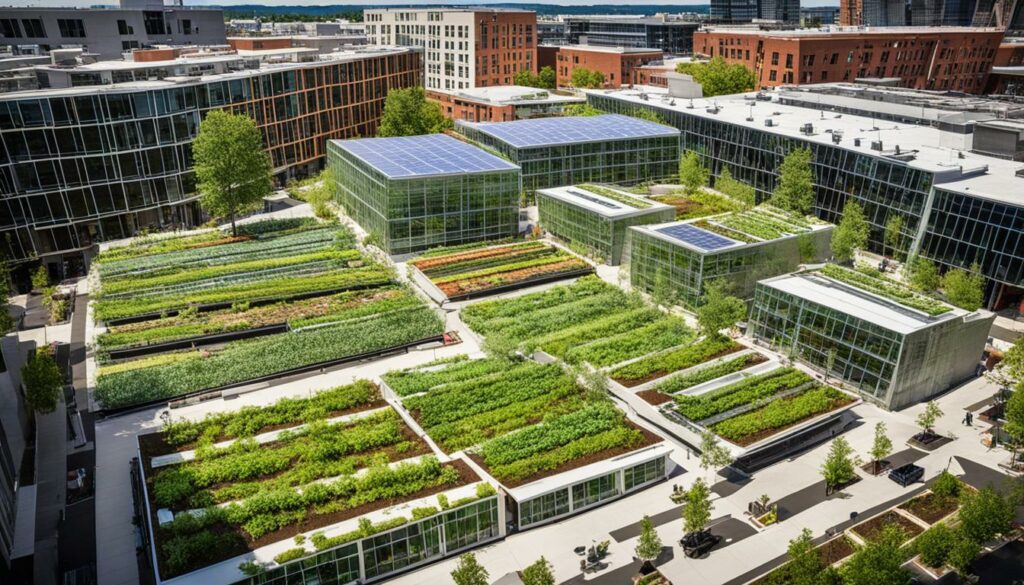
Fruits and vegetables grown in cities typically have a much larger carbon footprint. A key reason is the dense setup and short lifespan of urban farming infrastructure. This leads to a more carbon-heavy way of farming. Items such as infrastructure, supplies, and water for irrigation also add to the emissions.
Between 20% and 30% of city dwellers globally take part in urban agriculture. This includes everything from large urban farms to small personal or community plots. Even so, the emissions from these activities are high, averaging 0.42 kgCO₂e per serving. In comparison, traditional agriculture emits only 0.07 kgCO₂e for the same service.
Urban agriculture does have its advantages. For example, open-air tomatoes in city plots use less carbon than those from greenhouses. Certain crops grown intensively in cities might be more carbon-efficient than the traditional methods. Additionally, recycling waste and using it for farming could reduce emissions further.
This type of farming also meets social and dietary needs. It improves mental health, brings better nutrition, and weaves tighter social networks among residents. Moreover, it boosts city greenery, helps wildlife, fights urban heat, and cleans the air.
However, urban farming also faces challenges. Activities based on large amounts of infrastructure can emit a lot. To do better for the environment, it’s vital to focus on reusing materials and extending the life of infrastructure.
| Aspect | Urban Agriculture | Conventional Agriculture |
|---|---|---|
| Carbon Footprint (kgCO₂e per serving) | 0.42 | 0.07 |
| Carbon Intensity for Select Crops | Lower (Tomatoes) | Higher (Traditional Greenhouses) |
| Percentage of Global Urban Population Engaged | 20%-30% | – |
| Key Practices | Recycling, Extending Infrastructure Lifetimes | High Input, Monoculture |
| Social and Environmental Benefits | Improved Health, Increased Biodiversity | – |
So, urban agriculture might seem less environmentally friendly than standard farming. Yet, with the right strategies, it offers a path to lower impact while boosting social and dietary positives.
Working towards sustainable farming is essential for our planet. This involves reducing the carbon footprint in agriculture. By doing so, we can cut down on greenhouse gas emissions. This also improves the environment’s health through sustainable farming practices.
It’s key to keep farming structures working for longer. This lessens the frequent need for new constructions. Hence, it lowers the material emissions from these activities. Adopting renewable energy, like solar and wind power, helps farms use less fossil fuels.
Efficiency in using resources is crucial. Precision agriculture, which uses tech to apply water and chemicals precisely, is one method. This approach cuts waste and lowers emissions. Practices like crop rotation and agroforestry boost soil health and reduce carbon in the air. This is another way to fight the carbon footprint of agriculture.
Many farms are showing great results in sustainability. Bayer CropScience aims to cut their greenhouse gas emissions by 2024. This is a big step towards a greener future. Bunge has already lowered its emissions significantly. This shows big companies are making changes for our planet.
Projects by Biome Makers are also making a big impact. They aim to help over 147,609 farms by 2026. Using data and soil health analysis, they work on reducing emissions. This leads to better sustainability results.
The outcomes from these green efforts are significant. We’re seeing less pollution, better biodiversity, and healthier soil. It shows us that making farming more sustainable is possible. And, it’s very rewarding for our planet.
Below is a table comparing the greenhouse gas reductions of different farming methods:
| Agricultural Practice | Emission Reduction (units) | Environmental Impact |
|---|---|---|
| Conventional Greenhouses | 237 – 243 | Higher carbon intensity |
| Open-Air Urban Plots (Tomatoes) | Lower | Reduced carbon intensity |
| Urban Agriculture | 753 – 765 | Higher emissions |
| Conventional Agriculture with Crop Rotation | 57-70 (Dairy System, Australia) | Lower carbon footprint |
| Extended Infrastructure Lifetime | Significant Reduction | Efficient resource use |
Learning from these strategies and successes can make a big difference. We can work towards reducing farm emissions and enhancing the environment through sustainable farming.
Sustainable farming helps a lot to fight climate change. It does this by cutting down on fossil fuels and using natural fertilisers. This lowers the gases that harm our atmosphere produced in making food.
It’s really important to know how much different farming ways pollute. Research shows foods from urban farms can have six times more carbon footprint than usual. So, even though city farming is good, it faces emission challenges.
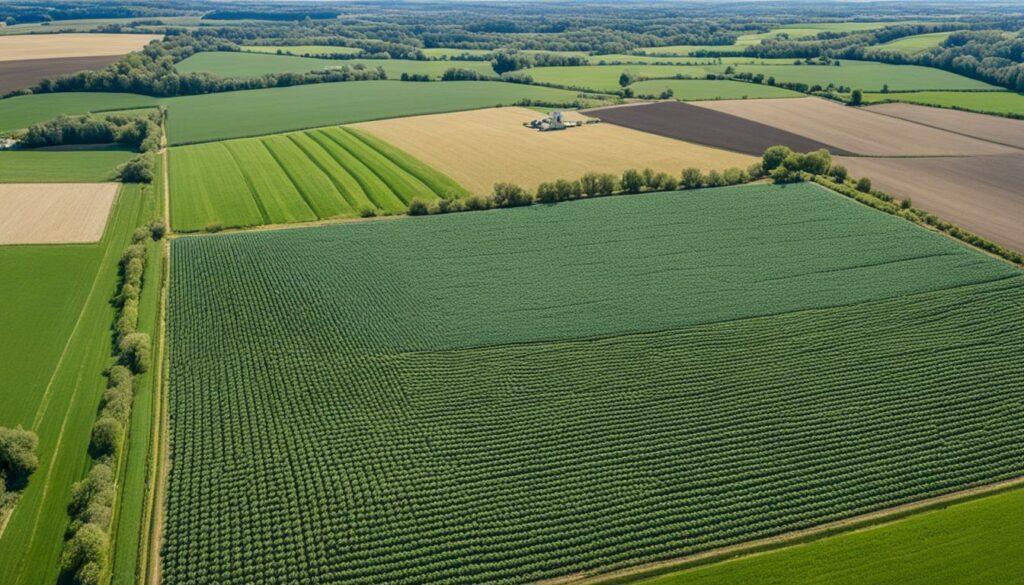
But not all crops are the same when it comes to pollution. Tomatoes grown outside in cities are better for the planet than those in greenhouses. Yet, flying in some foods makes their pollution same whether from city or normal farms. This shows reducing farming’s carbon footprint is tricky.
Let’s compare the good and bad of urban and normal farming:
| Aspect | Urban Agriculture | Conventional Farming |
|---|---|---|
| Carbon Footprint (per serving) | 0.42 kg CO2e | 0.07 kg CO2e |
| Infrastructure Impact | Higher due to material use | Lower |
| Efficiency in Production | Lower | Higher |
| Social Benefits | Potentially Higher | Lower |
Between 20% to 30% of city people worldwide do some urban farming. The main climate issue comes from the materials used in cities. So, using city waste for farming and making urban buildings last longer are powerful ways to lower pollution.
Over a quarter of the world’s greenhouse gases comes from making food. Sustainable farming is great for the planet and us too. It helps ecosystems, keeps water and soil healthy. By using these natural ways, we can reach the UN’s zero emissions goal by 2050.
The world of farming is changing fast because of new climate-friendly ideas. These new ways are not just good for the planet. They also help farms work better and last longer.
New tech is leading the farming revolution. Precision farming uses GPS, sensors, and data to wisely use resources. This helps cut down on waste, lowers pollution, and boosts harvests. Drones and smart tools watch over crops, spotting problems early to stop. This means farms can fix things before they get bad.
There are also exciting farming ideas that aren’t just about gadgets. Vertical farming is one. It grows crops on top of each other to save space. This means we can use less land. Hydroponics lets plants grow in water without using soil. This idea saves a lot of water, which we need for growing food.
Biochar is another cool method. It’s made from old plant stuff, and adding it to soil is great for the environment. It takes carbon out of the air. And, it makes soil better at holding water and helping plants grow.
Soon, more people are going to need food because the world’s population is growing. By using these new ways in farming, we can make sure we grow enough food sustainably. This is key for our farms to work well with the planet, producing more food, fighting off climate problems, and making less pollution.
| Innovation | Benefits |
|---|---|
| Precision Farming |
|
| Vertical Farming |
|
| Hydroponics |
|
| Biochar |
|
By using clever tech and new ideas, farming can feed more people without harming the planet. Investing in these ‘green’ methods can lead farming to a brighter, more sustainable future.
Sustainable farming has a big effect on local ecosystems. It mainly does this by helping different kinds of plants and animals to thrive. This, in turn, keeps the ecosystem healthy. Farmers use methods like planting many types of crops together. They also grow certain plants to cover the soil and use local plant types. This helps the soil stay healthy and makes sure there are plenty of bees and other pollinators around.
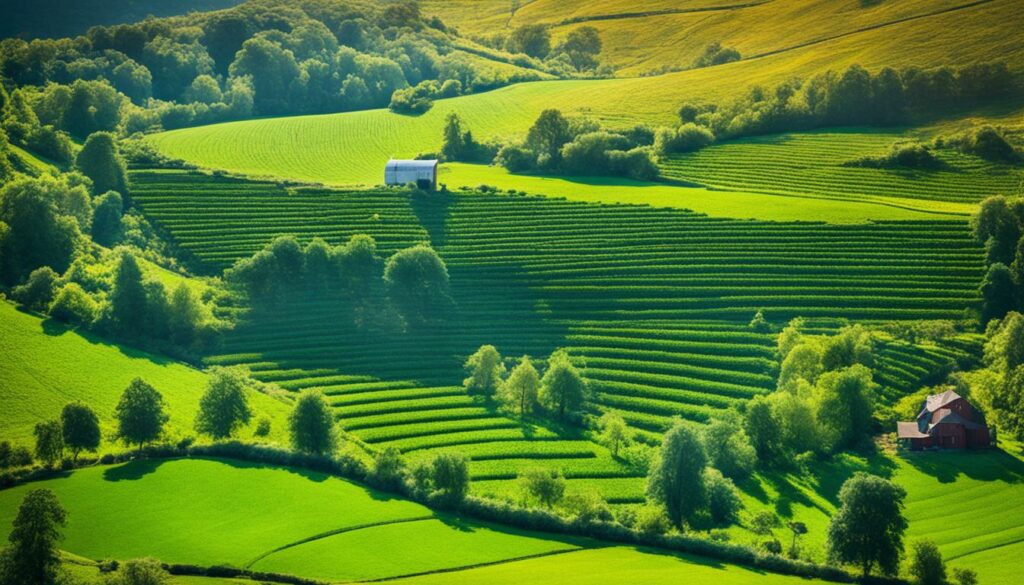
The impact of farming on the world is huge. Agriculture uses up more land than forests or wild fields do. It also takes most of the water we use and is a major cause of water pollution. This shows just how important it is for farmers to do things in a way that helps the environment.
A big part of farming is raising animals. But, the way we currently do it harms the planet a lot. Using different plants and methods can make things better. They help keep the local area’s ecosystem strong without needing as many chemicals or just one type of crop. This means we can have healthy farms and protect wildlife too.
Another big problem is the dirty water that comes from farms. This pollution harms rivers and lakes. By farming in a sustainable way, we can stop these bad effects. It also helps to make farms and nature work well together. This way, the environment can actually benefit from farming activities.
Transitioning to environmentally-friendly farming is vital. Today, agriculture faces severe weather like 100-year floods and droughts. This shows why we need strong environmental agricultural legislation.
Government rules and help are key for green farming. These give farmers funds and tools to fight climate change. For example, the National Sustainable Agriculture Coalition (NSAC) pushes for green policies. They focus on methods that respect nature and support everyone equally.
Help from public funds is essential for sustainable farms. It helps ecosystems, communities, and economy thrive. Incentives like organic fertiliser support and renewable energy grants cut down farm emissions. Many of these eco-friendly methods have worked for generations.
Working together globally is crucial too. It helps share wisdom and tech to fight climate change. These efforts spread green farming and boost new solutions. They make sure everyone has a role in policy-making, from different communities.
Government help and global teamwork are key to success. They take care of our planet, feeding the future, and spread all-around benefits.
Economic advantages sustainable farming offers many benefits. It helps increase profitability over time and makes farms more resilient to changes.
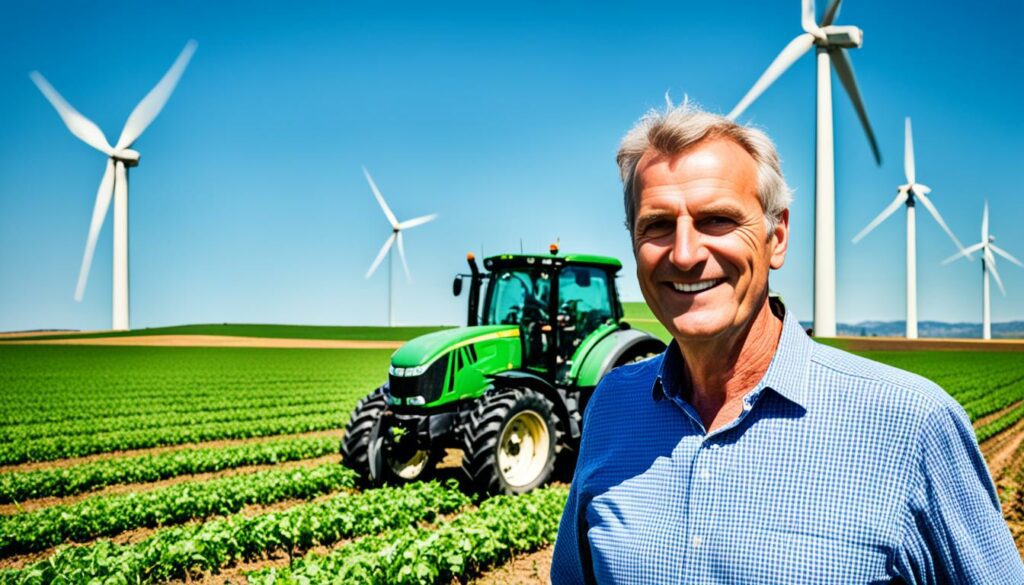
Using local resources and natural fertilisers can cut costs. This is cheaper than buying costly chemicals for farming.
It also helps farmers enter niche markets, especially for organic goods. More people now choose eco-friendly items, allowing farmers to charge higher prices. This makes the profitability of eco-agriculture clear in these markets.
Economic bonuses, such as subsidies and technical help, support going green. These aids encourage farmers to use sustainable methods.
Also, rules like certifications and green laws can help. They tie direct payments to meeting certain environmental goals. This encourages farmers to keep their land in good shape and boosts the economic benefits of sustainable farming.
Sustainable practices can make agricultural land more valuable. This is because they enhance the soil and promote more biodiversity. With the world’s growing population, we will need to produce more food. Sustainable farming helps meet this demand.
A study on 18,000 papers showed how incentives help both farms and the environment. These results highlight the importance of economic and environmental sustainability in farming.
The move towards sustainable farming shows promise. It not only brings economic gains but also protects our natural resources for the future.
Consumers are key in pushing for farming that’s kinder to the planet. They make a big difference by choosing local foods and those grown sustainably. With our planet’s population heading to 10 billion by 2050, it’s more important than ever. We need to ask for eco-friendly farming to meet the growing food needs without hurting our environment.
What we buy impacts how food is grown. Choosing foods that are not only tasty but also good for the planet encourages better farming. For example, by asking for foods that use less water or have been grown with care for the soil, we help nature.
This change in what consumers want means producers have to think more about the planet. It leads to farming that protects the environment and provides food that’s good for everyone. So, by picking eco-friendly foods, we’re helping not only ourselves but also our earth.
Buying food grown near where we live is a great step towards green living. It doesn’t travel as far to you, so there’s less harm to the environment. Also, it supports the people in your community, making the local economy stronger.
Local farmers who care about the planet benefit when we choose their produce. They find it easier to keep their farms running in a sustainable way. This means a better food system for us all and a healthier planet.
Our choice for eco-friendly food is more powerful than we may think. It leads to new ways of farming, makes farms stronger, and helps against climate change. Together, we help keep our world healthy, save resources, and build a future where food is made in a right way for everyone.
The path to sustainable farming faces many hurdles, with a special set of issues around carbon farming. This area demands careful handling.
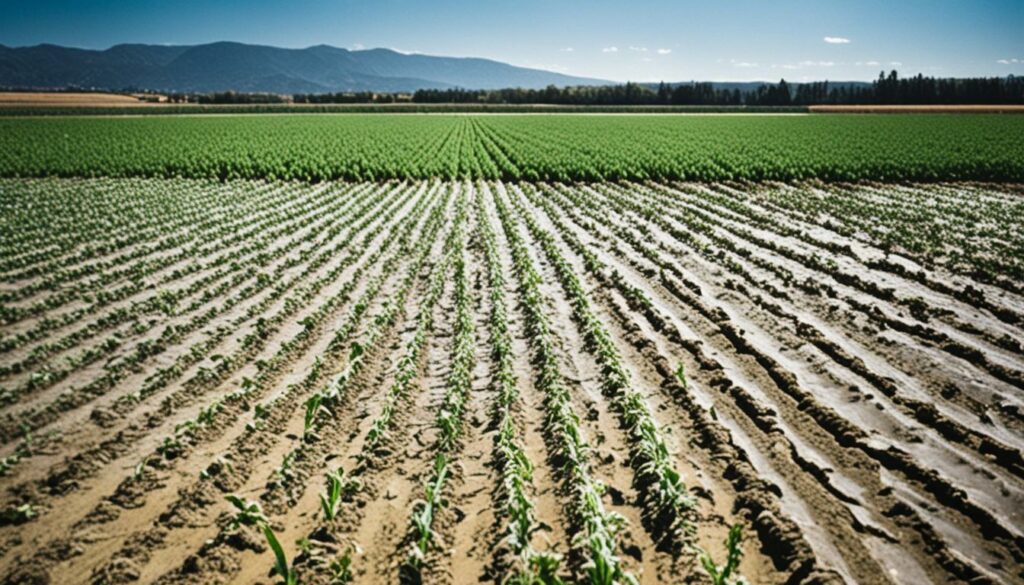
It’s vital to prove the newness of carbon projects. These initiatives must show they wouldn’t happen without support. But, checking this can be hard and raise fairness concerns. Some farmers may get more help than those who’ve long managed their lands well.
There’s also the issue of “leakage”. This happens when spreading organic materials doesn’t increase carbon capture. The limited amount soil can hold over time makes carbon farming less effective.
The issue of how we measure soil carbon is crucial. Having a trustworthy system is key for a sound carbon market. Yet, there can be challenges. For example, no-tillage is good for the soil but might push up pesticide use.
Tackling agriculture’s effect on global resources is urgent. It makes up a big part of the world’s greenhouse gas emissions. Agriculture uses a lot of land and most of the freshwater. Solving these problems is essential for a sustainable future.
“The limitations of carbon farming include the phenomenon of ‘leakage’ where transferring organic material across fields may not result in additional carbon sequestration.”
Examining sustainable farming case studies shows us how to improve farming. It lets us learn from different areas and farm types to get better at looking after the Earth. This is key to protect our environment.
A project in Lombardy, Italy, cut down water pollution. It saw a big decrease in harmful chemicals. For example, there was a 78% reduction in pesticide residue.
In Iowa, US, a project to protect soil during soybean planting had great results. It reduced pollution and greenhouse gases. This proves local actions can make a big positive impact.
In Arkansas, US, a project to reduce methane in rice fields was very successful. It led to a major drop in greenhouse gases. Targeted efforts were shown to work well.
In Badajoz, Spain, work on water and soil management for tomatoes cut emissions. It also boosted soil quality a lot. This shows what can be achieved locally.
Successful eco-farming examples are doing well worldwide. They cover large areas and show real benefits. These include reducing pollution and increasing soil health. Continuing this work is part of a larger effort to improve 300,000 hectares by this year. Unilever aims to help fix 1.5 million hectares of land and sea.
Vertical farming is making a big difference by using less energy. It’s better than traditional farming in many ways. For example, it’s much more energy-efficient. This is a big plus for the environment.
Techniques that save water and help use resources again are making farming more sustainable. They help to lower the carbon footprint of farming. These steps forward are helping agriculture be kinder to the planet.
To sum up, these case studies show us what we can achieve with eco-friendly farming. They reduce pollution and help nature to flourish. This way, farming and the environment can support each other.
Sustainable farming is changing the way we grow food for the better. It cuts down on harmful effects on the environment. This helps in the battle against climate change. Farmers are using earth-friendly actions, new technologies, and better policies. This makes agriculture stronger and kinder to our planet. The success of this green farming depends on all of us working together.
In the past, farming in the US and worldwide added to the planet’s warming. But now, things are improving. Farmers are using smarter ways, like no-till farming and special fertilisers. They’re also changing what they feed their animals to lower harmful gases. Joining eco-friendly programmes and using wind and solar energy are also big steps forward. These actions not only help the environment. They also create new chances for farm incomes. Plus, programmes like the Conservation Reserve Program offer bonuses for being green.
Making food has a big effect on our planet. It causes a lot of the world’s greenhouse gases and uses much of its usable land. So, it’s urgent that we reduce this damage. Farming smarter, like using less land and growing different crops, can help a lot. These actions store more carbon and protect the environment. By choosing these sustainable ways, we make sure the food system is strong for everyone in the future. This is a big change in how we do agriculture.
Sustainable farming is about keeping a balance with nature while growing food. It uses green methods to use resources better. This reduces the gases that harm our atmosphere and helps save the earth for the future.
Farming can add a lot of harmful gases to the air. By using smart farming methods, these emissions can be cut down. This is important to protect our planet and fight global warming.
By doing things differently, like mixing crops with animals and making better animal food, less bad gases are made. Using natural ways to grow food also helps cut down on harmful emissions.
Soil is like a big sponge, it can hold a lot of carbon. By farming in certain ways, like growing trees near crops and not disturbing the soil too much, we can lock away carbon. This makes the air cleaner for us all.
Regenerative farming is about healing the land and making it stronger against bad weather. These ways of farming can hold more carbon and stop the land from getting worse. They also make it better for plants and animals to thrive.
Sustainable farming works with nature to grow food. It uses natural methods that are good for the environment. On the other hand, traditional farming can harm the earth by using a lot of chemicals and growing only one type of crop.
Farming in cities can sometimes use a lot of energy and space. Yet, picking the right crops and managing them well can help a lot. This can make city farming good for the environment and the people living there.
To farm in a better way, we can use things longer, make the most of what we have, and pick clean energy. Many farms that do this have seen great results. They make less mess and make the land healthier for all.
Farming well can make the local environment a better place for plants and animals. Things like planting different types of crops together and using natural cover for the soil help a lot. They make the land richer and support bees and birds to live there.
Governments and groups from around the world work on rules and help for farming the right way. They guide and fund farmers to use methods that are kind to the land. This is to make sure farming is good for the earth everywhere.
Doing farming in a way that keeps the earth safe can have big money benefits. It costs less to run the farm and the things grown can be sold for more. This makes farming smarter and better for business.
What people choose to buy and eat can make a big difference in farming. By picking food that’s grown well, we show farmers what we like. This helps farmers use good methods that care for the planet.
Making farming good for the earth can be hard. It’s not always clear how much good it does or if it’s the best way to farm. These challenges need smart thinking and support to solve them.
There are many farms that show we can grow food without hurting the planet. From small farms that work with their community to big farms that grow everything organically, they prove it can be done. Their stories inspire others to farm in a way that’s good for all.